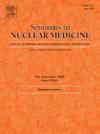FDG PET/CT诊断肺癌分期的最新进展。
IF 5.9
2区 医学
Q1 RADIOLOGY, NUCLEAR MEDICINE & MEDICAL IMAGING
引用次数: 0
摘要
在非小细胞肺癌(NSCLC)中,FDG PET/CT检查的CT部分对T(肿瘤)状态评估至关重要,而FDG部分检查中原发肿瘤的信息可能提供N(淋巴结)状态的额外信息。FDG PET/CT成像在识别NSCLC中淋巴结累及的总体敏感性为85%,特异性为84%。可预测FDG PET/CT未见NSCLC中ln累及风险的参数包括肿瘤大小及其随时间的增加、肿瘤分化程度、从初次诊断开始的天数、腺癌亚型、原发肿瘤的中心位置还是外周位置、固体还是混合固体磨砂玻璃放射学特征。包含这些变量的nomogram已经被发表并提供给临床使用。此外,FDG PET/CT成像在识别胸外转移瘤方面比常规形态学成像具有更高的灵敏度,尤其是在骨和肾上腺病变方面。在小细胞肺癌(SCLC)中,有限的可用数据显示,与传统分期相比,FDG PET/CT成像系统地更准确地用于分期目的,并导致高达15%的SCLC患者疾病分期(有限与广泛疾病)的改变。本文章由计算机程序翻译,如有差异,请以英文原文为准。
FDG PET/CT for Staging Lung Carcinoma: An Update
In non-small cell lung carcinoma (NSCLC) carcinoma, the CT-part of the FDG PET/CT examination is of primary importance for T (tumor)-status assessment, while information derived from the primary tumor on the FDG-part of the examination may provide additional information on N- (lymph node) status. FDG PET/CT imaging was shown to have an overall sensitivity of 85% and a specificity of 84% for identifying LN involvement in NSCLC. Parameters that may predict the presence and quantify the risk of LN-involvement in NSCLC missed on FDG PET/CT imaging are tumor size and its increase over time, tumor differentiation degree, the number of days elapsed from the time of initial diagnosis, an adenocarcinoma subtype, a central versus peripheral location of the primary tumor and a solid versus mixed solid-ground glass radiologic character. Nomograms incorporating several of these variables have been published and made available for clinical usage. Furthermore, FDG PET/CT imaging was shown to have an overall higher sensitivity for identifying extra-thoracic metastases than convential morphological imaging and this especially for bone and adrenal lesions. In small cell lung carcinoma (SCLC), limited available data have shown FDG PET/CT imaging to be systematically more accurate for staging purposes when compared to conventional staging and to lead to a change in disease stage (limited versus extensive disease) in up to 15% of SCLC-patients.
求助全文
通过发布文献求助,成功后即可免费获取论文全文。
去求助
来源期刊

Seminars in nuclear medicine
医学-核医学
CiteScore
9.80
自引率
6.10%
发文量
86
审稿时长
14 days
期刊介绍:
Seminars in Nuclear Medicine is the leading review journal in nuclear medicine. Each issue brings you expert reviews and commentary on a single topic as selected by the Editors. The journal contains extensive coverage of the field of nuclear medicine, including PET, SPECT, and other molecular imaging studies, and related imaging studies. Full-color illustrations are used throughout to highlight important findings. Seminars is included in PubMed/Medline, Thomson/ISI, and other major scientific indexes.
 求助内容:
求助内容: 应助结果提醒方式:
应助结果提醒方式:


